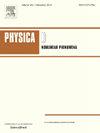三维Filippov系统退化Teixeira奇点的局部结构
IF 2.9
3区 数学
Q1 MATHEMATICS, APPLIED
引用次数: 0
摘要
本文的主要目的是强调三维菲利波夫系统中所谓的t奇点处的退化所产生的动力学的丰富性。更具体地说,我们描述了三维Filippov系统在一个不可见的双重奇点周围的局部滑动和交叉动力学,该系统表现出由系统的切线折叠曲线与切换流形之间的接触引起的退化。特别地,我们证明了当这两条曲线在这一点上的接触为2或3时,则从它发出一个非光滑的空竹,该空竹分别有一个分支或两个分支。我们还分析了一类Filippov系统的全局分岔,该分岔具有不可见的两重奇点,两重奇点之间有三次接触,我们证明了在从这个简并奇点分叉的t -奇点之间通过交叉异斜轨道而形成的不变面。最后,我们证明了这种情况在开关电路的应用模型中是自然出现的,这种奇点在特定的模型中是实现的。本文章由计算机程序翻译,如有差异,请以英文原文为准。
On the local structure of degenerate Teixeira singularities in 3D Filippov systems
The main goal of this paper is to emphasize the richness of the dynamics emanating from degeneracies at the so-called T-singularity in Filippov systems. More specifically, we characterize the local sliding and crossing dynamics around an invisible two-fold singularity in Filippov systems which presents a degeneracy arising from the contact between the tangency fold curves of a system with the switching manifold. In particular, we prove that, when the contact between such curves is 2 or 3 at this point, then it presents a nonsmooth diabolo emanating from it which has one branch or two branches, respectively.
We also analyze global bifurcations of a family of Filippov systems which presents an invisible two-fold singularity having a cubic contact between the fold curves and we show that there is an invariant surface foliated by crossing heteroclinic orbits between -singularities bifurcating from this degenerate singularity. Finally, we show that such kind of scenario appears naturally in applied models of switched electronic circuits and this singularity is realized in an specific model.
求助全文
通过发布文献求助,成功后即可免费获取论文全文。
去求助
来源期刊

Physica D: Nonlinear Phenomena
物理-物理:数学物理
CiteScore
7.30
自引率
7.50%
发文量
213
审稿时长
65 days
期刊介绍:
Physica D (Nonlinear Phenomena) publishes research and review articles reporting on experimental and theoretical works, techniques and ideas that advance the understanding of nonlinear phenomena. Topics encompass wave motion in physical, chemical and biological systems; physical or biological phenomena governed by nonlinear field equations, including hydrodynamics and turbulence; pattern formation and cooperative phenomena; instability, bifurcations, chaos, and space-time disorder; integrable/Hamiltonian systems; asymptotic analysis and, more generally, mathematical methods for nonlinear systems.
 求助内容:
求助内容: 应助结果提醒方式:
应助结果提醒方式:


